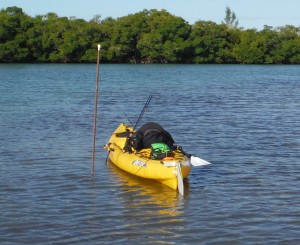Kayak fishing is a great way to spend the day. Drifting across clear water, seeing the grasses and fish in the shallow water, gliding along the mangroves watching for redfish and snook in the shady pockets and points created by the shoreline, and of course, catching quality fish. Many anglers, not from this area, think big fish and deep water are linked and for pelagic fish this can often be true. Tuna, sailfish, marlin, wahoo and dolphin [mahi-mahi] are prized game fish not commonly found on shallow flats.
Inshore species like redfish, sea trout, snook and others feed on the crabs, shrimp and juvenile fish found in this sea grass nursery. Simply put, the game fish are here because this is where their meals are served. Tides govern this environment and you must pay attention to them. As the tide ris es the game fish move onto the flat to feed. As the tide falls, they move out into the deeper water nearby so as not to be stranded. These shallow waters, particularly those with dark grasses, tend to warm up quickly in the winter if the sun is bright. It helps if these areas are also protected from the wind that would dissipate this solar warmth. Of course, these factors also make both game fish and kayak anglers happy.
es the game fish move onto the flat to feed. As the tide falls, they move out into the deeper water nearby so as not to be stranded. These shallow waters, particularly those with dark grasses, tend to warm up quickly in the winter if the sun is bright. It helps if these areas are also protected from the wind that would dissipate this solar warmth. Of course, these factors also make both game fish and kayak anglers happy.
In the winter, as the water clears, sight fishing these shallow waters is great. Sand areas among the grasses provide ambush points for predator fish as bait crosses these open areas. So…target these light, sandy areas with your casts and look there for larger fish silhouetted against the sand. Artificial shrimp or light [1/16 oz.] jigs with shad tails should be allowed to sink into these sand holes for the best strikes. Crawl your lure across the bottom and lift it as it approaches the grass. Flounder are often a surprise catch using this technique.
Most kayak anglers need to stretch their legs and stand up every now and then and wading from a kayak on a shallow grass flat is a great way to find fish and stand up for a while. The elevation you have when standing allows you to see into the water better than when seated in a kayak. The kayak can get you to some wading spots that are otherwise inaccessible from shore or even a flats skiff. The most important consideration as you start wading is the bottom makeup. Check with your paddle or a stake out pole to see if it happens to be bottomless mud. Sandy firm bottom is best for wading. It also is where you will find the sand holes mentioned above. So…check before you get out of your kayak.
If you do decide to wade away from your kayak, make sure it will stay there awaiting your return. Use your anchor and a stake out pole to be sure. Even though it may not be windy or seem like the kayak might wander away, a boat wake could bounce it around and the wind might come up. Some of the flats we fish are a long wade/swim away from shore, so I may be a little over cautious in my advice. Better safe than sorry. And of course, always do the “stingray shuffle” and avoid a painful encounter with these often hidden residents of shallow waters.
This is just one of the topics in our upcoming book “Angler’s Guide to Kayak Fishing Southwest Florida-Sarasota Bay to Charlotte Harbor” available this Fall. And, of course, it will be a waterproof pocket guide so it can go along with you in your kayak. Please check out our two current titles on the website at https://www.anglerpocketguides.com.
